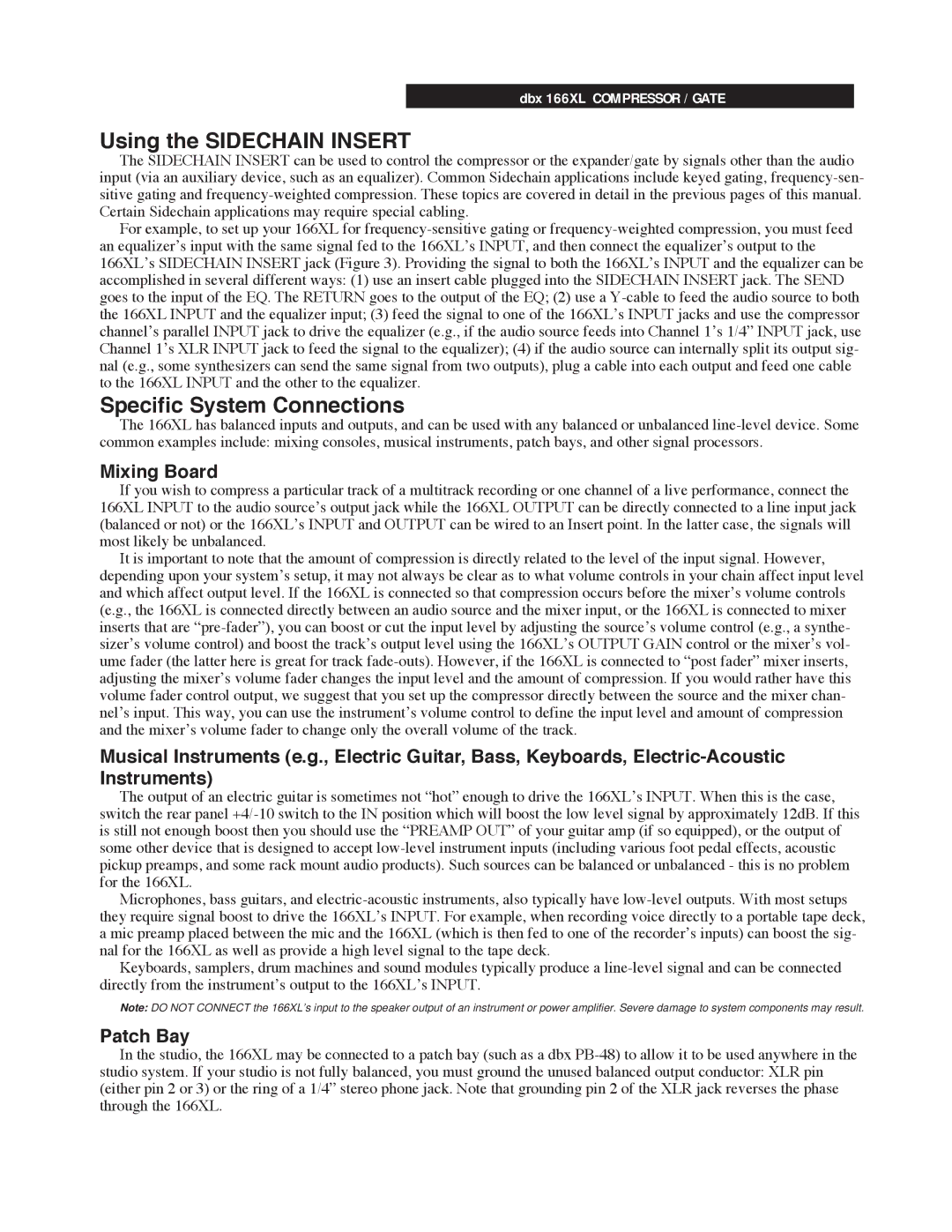dbx 166XL COMPRESSOR / GATE
Using the SIDECHAIN INSERT
The SIDECHAIN INSERT can be used to control the compressor or the expander/gate by signals other than the audio input (via an auxiliary device, such as an equalizer). Common Sidechain applications include keyed gating, frequency-sen- sitive gating and frequency-weighted compression. These topics are covered in detail in the previous pages of this manual. Certain Sidechain applications may require special cabling.
For example, to set up your 166XL for frequency-sensitive gating or frequency-weighted compression, you must feed an equalizerÕs input with the same signal fed to the 166XLÕs INPUT, and then connect the equalizerÕs output to the 166XLÕs SIDECHAIN INSERT jack (Figure 3). Providing the signal to both the 166XLÕs INPUT and the equalizer can be accomplished in several different ways: (1) use an insert cable plugged into the SIDECHAIN INSERT jack. The SEND goes to the input of the EQ. The RETURN goes to the output of the EQ; (2) use a Y-cable to feed the audio source to both the 166XL INPUT and the equalizer input; (3) feed the signal to one of the 166XLÕs INPUT jacks and use the compressor channelÕs parallel INPUT jack to drive the equalizer (e.g., if the audio source feeds into Channel 1Õs 1/4Ó INPUT jack, use Channel 1Õs XLR INPUT jack to feed the signal to the equalizer); (4) if the audio source can internally split its output sig- nal (e.g., some synthesizers can send the same signal from two outputs), plug a cable into each output and feed one cable to the 166XL INPUT and the other to the equalizer.
Specific System Connections
The 166XL has balanced inputs and outputs, and can be used with any balanced or unbalanced line-level device. Some common examples include: mixing consoles, musical instruments, patch bays, and other signal processors.
Mixing Board
If you wish to compress a particular track of a multitrack recording or one channel of a live performance, connect the 166XL INPUT to the audio sourceÕs output jack while the 166XL OUTPUT can be directly connected to a line input jack (balanced or not) or the 166XLÕs INPUT and OUTPUT can be wired to an Insert point. In the latter case, the signals will most likely be unbalanced.
It is important to note that the amount of compression is directly related to the level of the input signal. However, depending upon your systemÕs setup, it may not always be clear as to what volume controls in your chain affect input level and which affect output level. If the 166XL is connected so that compression occurs before the mixerÕs volume controls (e.g., the 166XL is connected directly between an audio source and the mixer input, or the 166XL is connected to mixer inserts that are Òpre-faderÓ), you can boost or cut the input level by adjusting the sourceÕs volume control (e.g., a synthe- sizerÕs volume control) and boost the trackÕs output level using the 166XLÕs OUTPUT GAIN control or the mixerÕs vol- ume fader (the latter here is great for track fade-outs). However, if the 166XL is connected to Òpost faderÓ mixer inserts, adjusting the mixerÕs volume fader changes the input level and the amount of compression. If you would rather have this volume fader control output, we suggest that you set up the compressor directly between the source and the mixer chan- nelÕs input. This way, you can use the instrumentÕs volume control to define the input level and amount of compression and the mixerÕs volume fader to change only the overall volume of the track.
Musical Instruments (e.g., Electric Guitar, Bass, Keyboards, Electric-Acoustic Instruments)
The output of an electric guitar is sometimes not ÒhotÓ enough to drive the 166XLÕs INPUT. When this is the case, switch the rear panel +4/-10 switch to the IN position which will boost the low level signal by approximately 12dB. If this is still not enough boost then you should use the ÒPREAMP OUTÓ of your guitar amp (if so equipped), or the output of some other device that is designed to accept low-level instrument inputs (including various foot pedal effects, acoustic pickup preamps, and some rack mount audio products). Such sources can be balanced or unbalanced - this is no problem for the 166XL.
Microphones, bass guitars, and electric-acoustic instruments, also typically have low-level outputs. With most setups they require signal boost to drive the 166XLÕs INPUT. For example, when recording voice directly to a portable tape deck, a mic preamp placed between the mic and the 166XL (which is then fed to one of the recorderÕs inputs) can boost the sig- nal for the 166XL as well as provide a high level signal to the tape deck.
Keyboards, samplers, drum machines and sound modules typically produce a line-level signal and can be connected directly from the instrumentÕs output to the 166XLÕs INPUT.
Note: DO NOT CONNECT the 166XL’s input to the speaker output of an instrument or power amplifier. Severe damage to system components may result.
Patch Bay
In the studio, the 166XL may be connected to a patch bay (such as a dbx PB-48) to allow it to be used anywhere in the studio system. If your studio is not fully balanced, you must ground the unused balanced output conductor: XLR pin (either pin 2 or 3) or the ring of a 1/4Ó stereo phone jack. Note that grounding pin 2 of the XLR jack reverses the phase through the 166XL.
